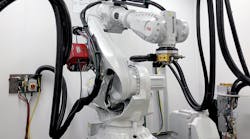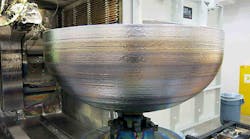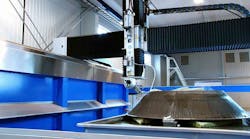Lockheed Martin is researching artificial intelligence in connection with additive manufacturing of complex metal parts, under a two-year, $5.8-million contract with the Office of Naval Research. The exercise in machine learning seeks to teach robots to oversee and optimize 3D printing programs.
The research is being conducted at the Lockheed Martin Space in Denver, where 3D printing is performed to produce parts for various space programs. For example, recently Lockheed printed a large-dimension titanium dome for a satellite fuel tank.
The Office of Naval Research is a U.S. Navy department that coordinates and carries out science and technology programs for the Navy and U.S. Marine Corps, working with academic, government, commercial, and non-profit organizations.
In their research, Lockheed and ONR will customize multi-axis robots to produce metal parts by laser deposition. Their first efforts will research 3DP of Ti-6AI-4V, a common titanium alloy, and integrate those efforts with research by seven other industry, national lab and university partners.
The purpose of the research is to optimize the production of high-value, complex parts, which at the present time “require constant monitoring by expert specialists to get them right,” according to Lockheed’s announcement.
"When you can trust a robotic system to make a quality part, that opens the door to who can build usable parts and where you build them," according to Zach Loftus, a Lockheed Martin fellow for additive manufacturing. "Think about sustainment and how a maintainer can print a replacement part at sea, or a mechanic print a replacement part for a truck deep in the desert. This takes 3D printing to the next, big step of deployment."
Lockheed noted the project also will help improve the reliability of 3DP results. For example, if one section of a part is of substandard quality the entire part may be useless. While It's common practice now to build individual parts to compensate for its weakest section, resulting in greater mass throughout the part. The Lockheed research will allow machines to optimize 3DP structures based on previously verified analysis.
That analysis, and its integration into a 3D printing robotic system, will scrutinize common types of microstructures used in an additive build. The researchers will measure the performance attributes of a machine parameters and those microstructures, and coordinate them to material properties before integrating this knowledge into a working system. With the resulting information, machines will be able to make decisions about how to print a part with the best results.
"We will research ways machines can observe, learn and make decisions by themselves, to make better parts that are more consistent," said Brian Griffith, Lockheed Martin's project manager. "Machines should monitor and make adjustments on their own during printing to ensure that they create the right material properties during production."








